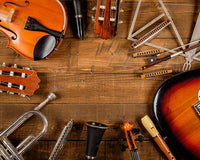Every instrument - including the Classical Guitar - has many supplementary products available to go along with it, ranging from necessity to luxury. To avoid any confusion when looking into such accessories, the following should explain why you’d need them, as well as some good options for buying them!
Strings
Your guitar strings are the things that you are going to want to get right. Everyone prefers different brands, tensions and gauges, so you should experiment a bit to find what you like. Some will find that very standard normal tension string sets are just fine. In this case you have a lot of options that can be inexpensive. Others will mix tensions and string gauges to fit what they like the most. This requires a lot more investigation and cost in a lot of cases, but it’s worth it to achieve the feel and sound that you want!
The main variable in Classical Guitar strings is the tension. The tensions normally seen are Normal and Hard. While you do see Extra Hard and Light tensions, they aren’t as common.
Normal tension strings are easier on the fingers, create a softer tone, and are often the standard tension supplied from the factory. Hard tension strings are slightly tougher to play as their tension is increased. They also tend to be louder and brighter in tone.
D’addario are very popular across all types of guitar, with this, their
standard classical strings are very reliable. If you want to try something a bit more expensive they have their
Pro-Arte models.
These are very highly regarded but they do cost a bit more.
Augustine are another well respected brand, they specify in nylon strings as they are the originator of the nylon guitar string. Prior to Albert Augustine’s innovation, traditional catgut strings were used for Classical guitars. Still very popular as a string manufacturer, you can’t go wrong with the brand that came first!
If you’re looking for something inexpensive, Stagg offer both a
normal tension and
hard tension set of nylon strings which will do just fine without spending too much money!


Footstool
For a classical player,
a footstool is almost a necessity. While it is possible to play with the proper classical form without, it makes things much easier to have a footstool to raise your leg to ensure the guitar rests at the correct angle.
An inexpensive item but can be incredibly important to the right player. If you are someone who is using a classical guitar but not playing classical music it’s something you can give a miss.
Guitar foot stools are usually adjustable to adhere to the player’s preference in height.

Get a footstool, because this... this is all kinds of wrong. And uncomfortable.

Bag or Case
Regardless of whether you’re transporting your instrument or not, it’s useful to have a
bag or case. They will act as protection and as a dust cover while being stored. So, if you are moving between performances or lessons, you will definitely want one. But even if you are keeping your guitar safely at home then a bag or case will ensure that your instrument stays in good condition. Even if being stored amongst other things.
An inexpensive gigbag can be a good option if you don’t want anything too bulky, or if you require back straps and storage pouches. While not as protective as hardcases, they are much lighter and can still protect from general bumps.
Hardcases are better for the musician who is traveling a lot, especially with other equipment, as they can withstand a lot more pressure and weight than a gigbag. Though with this they are more expensive.


Tuner
There are a lot of ways to keep your guitar in tune now, from external tuners like the ones I will talk about, to phone apps, to tuners built into the guitar. Some may even prefer a more traditional method such as using a
tuning fork.
With acoustic instruments I would generally recommend a
clip-on tuner. They are compact, clear, have a near endless battery life and don’t require any additional cables.
A chromatic tuner can ensure you can keep your guitar in tune but also allows you to tune to notes outside of the standard tuning of EADGBe. If you are considering open tunings or even simple altered tunings a chromatic tuner would be ideal.
If you don’t foresee needing to move outside of the standard tuning, or if you struggle to remember the notes required, then the
Rocket RT40G has a simple interface that tells you which string you’re playing and how far out of tune you are.


Capo
Capos are one of the more common accessories across all types of guitar, as well as other fretted instruments. They are used to raise the pitch of the guitars open strings to allow easier access to certain notes. For example, an open E chord played with the capo on the first fret becomes an F chord. This can be helpful playing Classical pieces not originally composed for the guitar.
With Classical guitar, you are going to want a
flat capo rather than a curved capo. The fretboard on a classical guitar is very flat, where acoustic or electric guitars will have some radius to them. Due to this, a standard “curved” capo won’t be as effective.
Two standard varieties of capo exist,
a trigger capo and a
wrap-around capo. The trigger capos ensure that you can place and remove the capo quickly, but they are slightly bulkier. The wrap-around style is a bit more cumbersome to put on, but is small enough to fit into your pocket.


 Get a footstool, because this... this is all kinds of wrong. And uncomfortable.
Get a footstool, because this... this is all kinds of wrong. And uncomfortable.






















